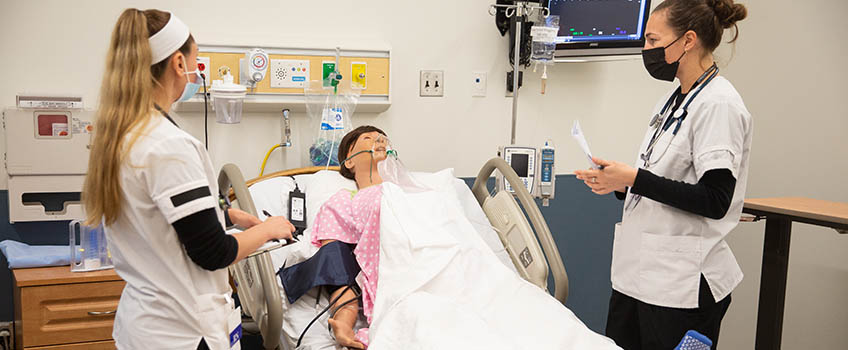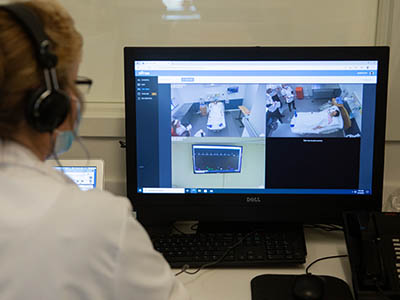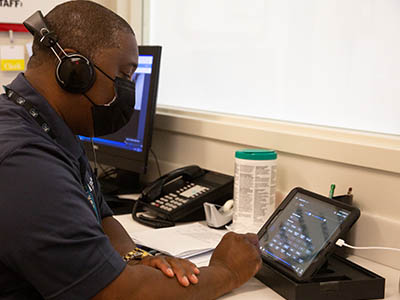Simulations Challenge Nursing Students

Nursing students prepare "patient' in the simulation lab. (Photos by Susan Allen/Stockton University)
Galloway, N.J. – The patient was in pain. The patient was hungry but wanted a cheesesteak, not Jell-O. The patient’s medicine had not been delivered to his room.
The 82-year-old “patient” in the simulation lab at the John F. Scarpa Health Sciences Center at Stockton University was really instructor Denise Petro. Working from a computer, she created and monitored a series of situations for nursing students that they might experience in a real hospital – though maybe not all at the same time.
 Stockton’s simulation labs got an extra heavy workout this year as students could
not spend as much time in real clinical settings due to COVID-19 restrictions at hospitals.
The faculty instead created simulations of real-life situations using the advanced
“patient” that can talk, breathe, bleed, and even deliver a baby.
Stockton’s simulation labs got an extra heavy workout this year as students could
not spend as much time in real clinical settings due to COVID-19 restrictions at hospitals.
The faculty instead created simulations of real-life situations using the advanced
“patient” that can talk, breathe, bleed, and even deliver a baby.
The students spent the morning with the patient as they were prepared for surgery, then returned in the afternoon to monitor the patient’s post-op care, which included some complications.
Assistant Professor of Nursing Jill Tourtual said the simulations provide a safe environment for the students to learn from experience.
“If you make a mistake, nothing happens,” she said. “But we set it up so they have to solve real-life problems, like what to do if the medicine is not in the room.
The Health Sciences Center has three simulation suites plus exam rooms where real students (often theater majors) play the patients.
 The pandemic has created more work for simulation coordinator Ken Davis, who proposed
to the faculty that they use the simulation lab to supplement clinical hours.
The pandemic has created more work for simulation coordinator Ken Davis, who proposed
to the faculty that they use the simulation lab to supplement clinical hours.
“I said I had some dates they could use and they jumped on board,” he said. “They told me what they wanted the patient to do so the students have a meaningful learning experience. It has been busy doing the different simulations.”
The labs are used by undergraduate and graduate students. The most advanced “patient” can simulate breathing, blood pressure, and even pregnancy. The eyes move and patient will react if given the wrong medicine. The faculty control the simulation via a computer terminal.
Tourtual said while a real-life clinical experience is ideal, sometimes there are days when not much is happening, so they never know for sure what the students are going to experience. In the lab, they can program exactly what they want to happen.
Students said they really valued the simulation lab experience and would even like to see it used more as a bridge between the classroom and a hospital room.
“In a clinical experience you do get to see more real-life situations,” said Michaella Butrico of Toms River, who is in the Accelerated BSN program. “But (the simulation) was very real. The patient blinked, and you could hear the heart sounds. It was a more overall experience.”
Student Amber Minnick of Toms River said the simulation gives them time to think and process information.
“You can stop and not worry you’re going to injure the patient. It’s taking the classroom training and applying it, but in a safe space.”
“It takes away the anxiety,” Butrico said.
More information about Stockton University health science and nursing programs is at stockton.edu/healthsciences
- Reported by Diane D'Amico


